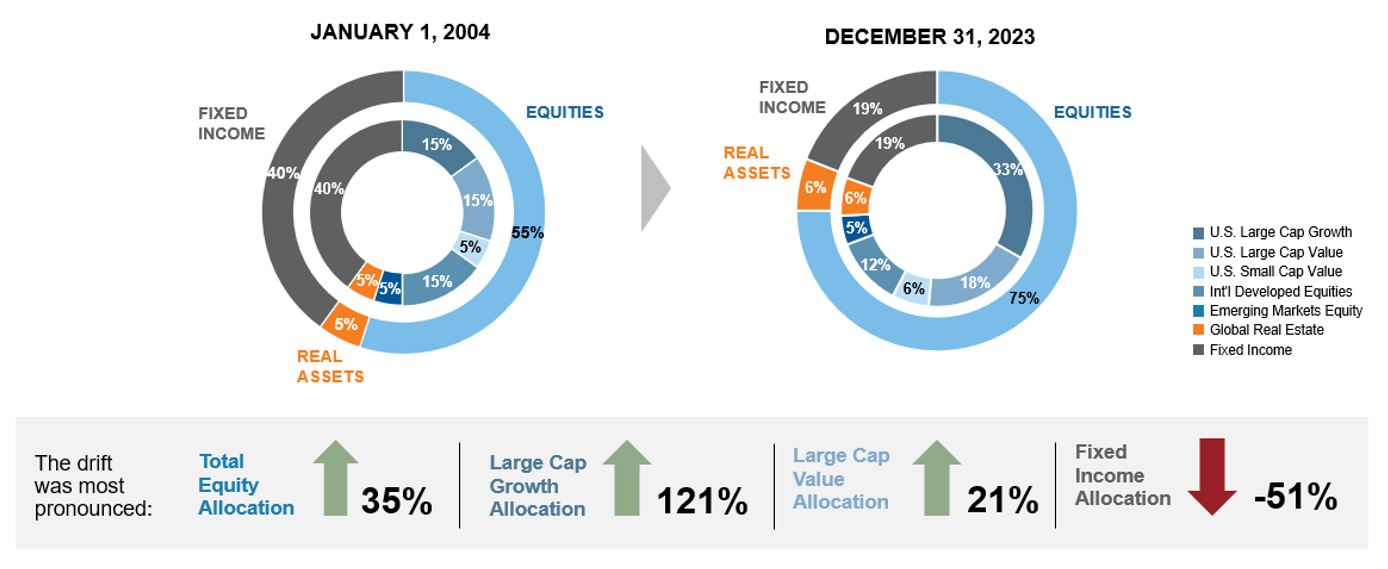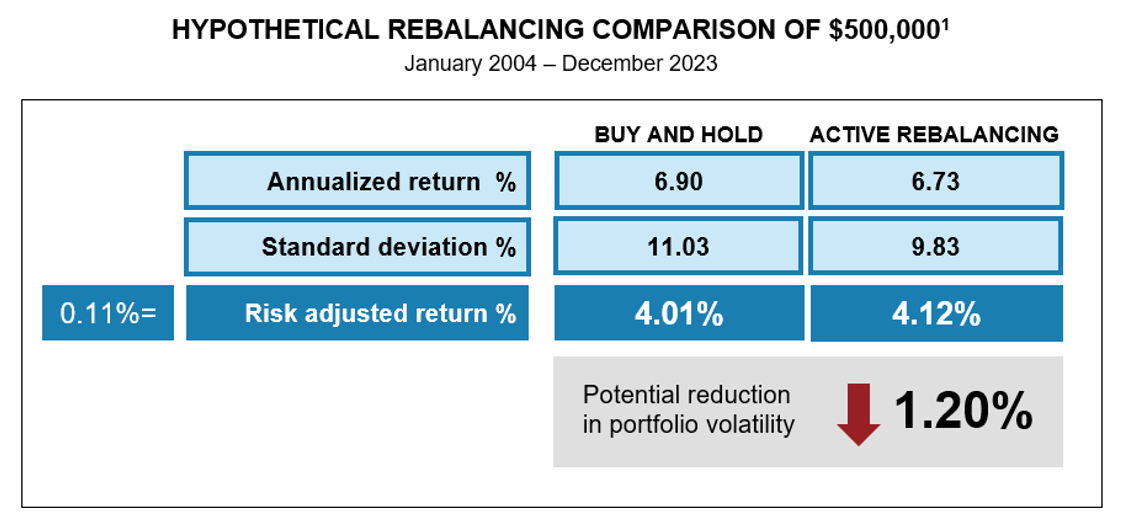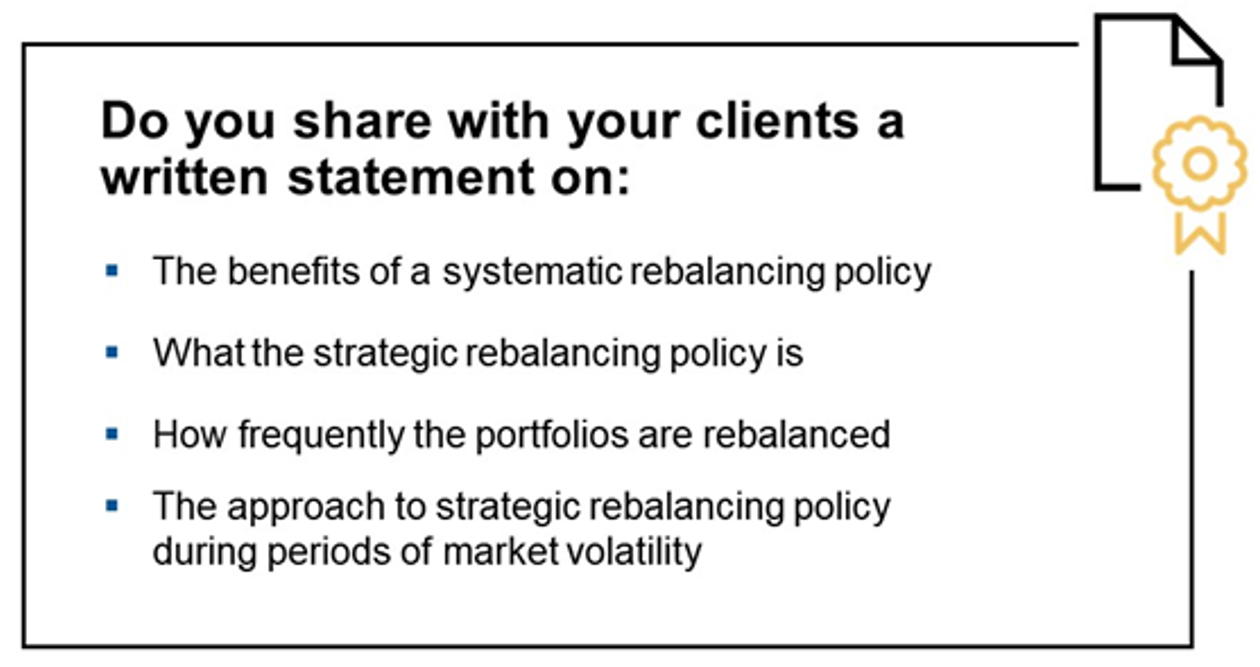by Nancy Fahmy, Russell Investments
Executive summary:
- Ensuring a portfolio is actively and regularly rebalanced is one of the key duties of a financial advisor
- Rebalancing can keep a portfolio within the desired asset allocation so that it remains in line with the investor’s goals
- That also helps keep the portfolio within the investor’s comfort zone
- Many investors and advisors take rebalancing for granted because it’s often done behind the scenes – but we believe it holds significant value
It’s not just about the destination, it’s the ride we take to get you there.
At Russell Investments, we believe in the value of an advisor. We believe that advisors are never more important than during periods of the unknown – and this year there’s a lot of unknowns. We don’t know whether central banks have been able to get inflation under control, whether interest rates will go down – nor at what pace if they do – or whether the economy will slide into recession or not. There’s also plenty of political uncertainty, with approximately 64 countries holding elections this year – including in the U.S.
We believe advisors play a critical role in steering investors through the various market environments they may encounter over their lives – and through the various major life events they undergo. That’s why we’ll be sharing four deeper dive blog posts that dig into the details of our annual study on this topic.
This is our first of the four and it focuses on the first letter in our tried-and-true formula: A, which represents Active rebalancing and asset allocation.
We all know that rebalancing is important, and asset allocation is key to a portfolio’s success. But you may be like many advisors who take rebalancing for granted because your firm may automate it. Well, the point isn’t so much who is doing the rebalancing. The point is: would your clients actively rebalance their portfolios if left to their own devices? Would their asset allocation remain in line with their stated goals if they didn’t have the guidance of a financial advisor?
Let’s think about that for a minute because what IS rebalancing? It’s buying more of what has just hurt a portfolio and selling what’s done well. Who has a client who embraces that sort of investment philosophy and discipline with open arms?
This is where the advisor’s role is vital. Even if the rebalancing is done behind the scenes, a client working with an advisor is more likely to have their portfolio regularly rebalanced to ensure it remains aligned with its original asset allocation. And that is more likely to keep the investor within their risk comfort zone.
Minimize the drift
As the chart below demonstrates, a hypothetical balanced index portfolio that has not been rebalanced would look more like a growth portfolio and expose the investor to risk they may not have agreed to. When purchased on January 1, 2004, it was a traditional 60% equities/40% fixed income portfolio. But by the end of December 2023, the equity allocation had ballooned to 81% of the portfolio, with the weighting in U.S. large-cap growth names more than doubling. Any sudden downturn in those growth names would have a disproportionate impact on that portfolio – and may lead to an uncomfortable phone call or two.
(Click image to enlarge)
 For illustrative purposes only. Not intended to represent any actual investment.
For illustrative purposes only. Not intended to represent any actual investment.
Active rebalancing not only keeps asset allocation in line with stated goals, it has the potential to reduce volatility – which can also do a lot to keep an investor in their comfort zone. That’s what makes the risk-adjusted return so important – and why we believe it’s a value-add that an advisor brings to the table. Returns only matter if the investor remains committed to their investing journey.
(Click image to enlarge)

1 For illustrative purposes only. Not meant to represent any actual investment. Standard deviation is a statistical measure of the degree to which an individual value in a probability distribution tends to vary from the mean of the distribution. The greater the degree of dispersion, the greater the risk. Risk adjusted return measures the riskless rate of return that provides the same level of utility to the investor as the variable excess returns of a risky portfolio.
The value communication gap
Do your clients recognize the value of what you do ? Establishing the value of all the good things that advisors do is dependent on regular and detailed communication. This communication should cross styles. It should not just include what you write—via client emails, your online presence, or via traditional mail—but should also include what you say when you are face-to-face, phone-to-phone, or on a video chat with clients.
We consistently find there is a disconnect between what advisors do and what their clients think they do. In other words, there is a value communication gap between advisors and their clients. Advisors don’t always know what their clients really value . And they don’t always understand what they should do less of and what they should do more of.
We believe that active rebalancing to ensure alignment with the client’s chosen asset allocation is one of the most vital functions advisors provide. But the value of it is often downplayed, probably by the advisors themselves. Why? Because it’s something they set up for the client and then leave on automatic. But just because it isn’t a hands-on and time-consuming duty doesn’t mean it’s not important. Remember, your clients would not have their portfolios rebalanced at all if they weren’t working with you.
Unless you clearly communicate the value of rebalancing, don’t expect your clients to appreciate it. They should because we think clients practice reverse rebalancing much of the time. We believe that without the help of advisors, clients are more likely to make serious behavioral mistakes, such as buying high, selling low, or running to cash at precisely the wrong time.
How to tell the rebalancing story
Do your investor clients recognize the value of actively rebalancing and how it’s a vital part of wealth management? If advisors don’t talk about rebalancing, don’t name it and don’t have conversations about it, then we can’t expect investors to understand its importance. We recommend four simple touchpoints to make the communication both easy for you and meaningful for your clients.
(Click image to enlarge)
- The benefits of a systematic rebalancing policy—Explain what can happen if rebalancing doesn’t happen and how active rebalancing helps keep their asset allocation on track with their goals and their risk profiles.
- What the strategic rebalancing policy is—Let your clients know the basics of the policy, how it works to be both efficient and oriented toward their desired outcomes.
- How frequently the portfolios are rebalanced—Explain how often strategic rebalancing happens and why you believe that frequency makes sense for them.
- The approach to strategic rebalancing policy during periods of market volatility—Let your clients know how sticking to a long-term, disciplined rebalancing policy can help them avoid costly mistakes, such as following the herd, buying high and selling low, and leaving the market at the worst times.
The bottom line
Rebalancing may be largely automated, but it remains an important element of the value you bring to your clients. For them to understand the value of strategic rebalancing, you need to talk about it. This doesn’t have to be a complicated conversation. But we believe it needs to happen, because rebalancing is a key part of helping investors achieve the financial security that matters so much to them.
To learn more about the 2024 Value of an Advisor Study, click here.
Copyright © Russell Investments















